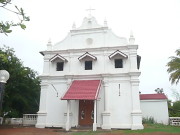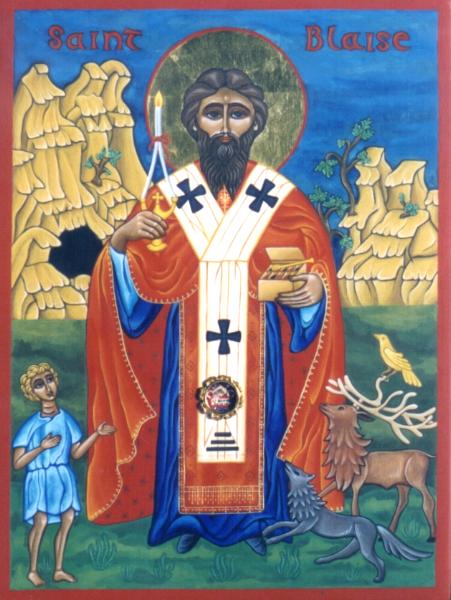
St. Blaise

St. Blaise, also known as Saint Blase, was a physician, and bishop of Sebastea in historical Armenia (modern Sivas, Turkey). According to the Acta Sanctorum, he was martyred by being beaten, attacked with iron combs, and beheaded. He is the patron saint of wool combers.
The first reference we have to St. Blaise is in manuscripts of the medical writings of Aëtius Amidenus, a court physician of the very end of the 5th or the beginning of the 6th century; there his aid is invoked in treating objects stuck in the throat.
Marco Polo reported the place where “Meeser Saint Blaise obtained the glorious crown of martyrdom”, Sebastea; the shrine near the citadel mount was mentioned by William of Rubruck in 1253. However, it appears to no longer exist.
From being a healer of bodily ailments, St. Blaise became a physician of souls, then retired for a time, by divine inspiration, to a cavern where he remained in prayer. As bishop of Sebastea, St. Blaise instructed his people as much by his example as by his words, and the great virtues and sanctity of the servant of God were attested by many miracles. From all parts, the people came flocking to him for the cure of bodily and spiritual ills. He is said to have healed animals (who came to the saint on their own for his assistance) and to have been assisted by animals.
In 316, the governor of Cappadocia and Lesser Armenia Agricolaus began a persecution by order of the Emperor Licinius and Saint Blaise was seized. After his interrogation and a severe scourging, he was hurried off to prison, and subsequently beheaded.
In Cornwall the village of St Blazey derives from his name, where the parish church is still dedicated to St. Blaise. Indeed, the council of Oxford in 1222 forbade all work on his festival. There is a church dedicated to Saint Blaise in the Devon hamlet of Haccombe, near Newton Abbot (Also one at Shanklin on the Isle of Wight and another at Milton near Abingdon in Oxfordshire), one of the country’s smallest churches. It is located next to Haccombe house which is the family home of the Carew family, descendants of the vice admiral on board the Mary Rose at the time of her sinking. One curious fact associated with this church is that its “vicar” goes by the title of “archpriest”.
There is a St. Blaise’s Well In Bromley, Kent [9] where the water was considered to have medicinal virtues. St Blaise is also associated with Stretford in Lancashire. A Blessing of the Throats ceremony is held on February 3 at St Etheldreda’s Church in London and in Balve, Germany.
In Bradford, West Yorkshire a Roman Catholic middle school named after St Blaise was operated by the Diocese of Leeds from 1961 to 1995. The name was chosen due to the connections of Bradford to the woollen industry and the method that St Blaise was martyred, with the woolcomb. Due to reorganisation the school closed down when Catholic middle schools were phased out, and the building was sold to Bradford Council to provide replacement accommodation for another local middle school which had burned down. Within a few months, St Blaise school was also severely damaged in a fire, and the remains of the building were demolished. A new primary school was built on the land, and most of the extensive grounds were sold off for housing.
Saint Blaise (Croatian: Sveti Vlaho or Sveti Blaž) is the patron saint of the city of Dubrovnik and formerly the protector of the independent Republic of Ragusa. At Dubrovnik his feast is celebrated yearly on 3 February, when relics of the saint, his head, a bit of bone from his throat, his right hand and his left, are paraded in reliquaries. The festivities begin the previous day, Candlemas, when white doves are released. Chroniclers of Dubrovnik such as Rastic and Ranjina attribute his veneration there to a vision in 971 to warn the inhabitants of an impending attack by the Venetians, whose galleys had dropped anchor in Gruž and near Lokrum, ostensibly to resupply their water but furtively to spy out the city’s defenses. St. Blaise (Blasius) revealed their pernicious plan to Stojko, a canon of St. Stephen’s Cathedral. The Senate summoned Stojko, who told them in detail how St. Blaise had appeared before him as an old man with a long beard and a bishop’s mitre and staff. In this form the effigy of Blaise remained on Dubrovnik’s state seal and coinage until the Napoleonic era.
In England in the 18th and 19th centuries Blaise was adopted as mascot of woolworkers’ pageants, particularly in Essex, Yorkshire, Wiltshire and Norwich. The popular enthusiasm for the saint is explained by the belief that Blaise had brought prosperity (as symbolised by the Woolsack) to England by teaching the English to comb wool. According to the tradition as recorded in printed broadsheets, Blaise came from Jersey, Channel Islands. Jersey was certainly a centre of export of woollen goods (as witnessed by the name jersey for the woollen textile). However, this legend is probably the result of confusion with a different saint, Blasius of Caesarea (Caesarea being also the Latin name of Jersey).
In iconography, Blaise is represented holding two crossed candles in his hand (the Blessing of St. Blaise), or in a cave surrounded by wild beasts, as he was found by the hunters of the governor. He is often shown with the instruments of his martyrdom, steel combs. The similarity of these instruments of torture to wool combs led to his adoption as the patron saint of wool combers in particular, and the wool trade in general. He may also be depicted with crossed candles. Such crossed candles are used for the blessing of throats on his feast day, which falls on 3 February, the day after Candlemas on the General Roman Calendar. Blaise is traditionally believed to intercede in cases of throat illnesses, especially for fish-bones stuck in the throat.